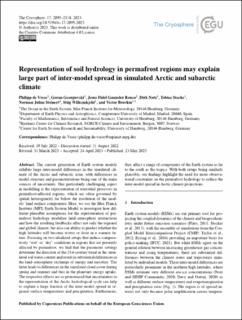| dc.contributor.author | de Vrese, Philipp | |
| dc.contributor.author | Georgievski, Goran | |
| dc.contributor.author | Gonzalez Rouco, Jesus Fidel | |
| dc.contributor.author | Notz, Dirk | |
| dc.contributor.author | Stacke, Tobias | |
| dc.contributor.author | Steinert, Norman | |
| dc.contributor.author | Wilkenskjeld, Stiig | |
| dc.contributor.author | Brovkin, Victor | |
| dc.date.accessioned | 2023-09-20T09:17:48Z | |
| dc.date.available | 2023-09-20T09:17:48Z | |
| dc.date.created | 2022-11-22T11:40:50Z | |
| dc.date.issued | 2023 | |
| dc.identifier.issn | 1994-0416 | |
| dc.identifier.uri | https://hdl.handle.net/11250/3090745 | |
| dc.description.abstract | The current generation of Earth system models exhibits large inter-model differences in the simulated climate of the Arctic and subarctic zone, with differences in model structure and parametrizations being one of the main sources of uncertainty. One particularly challenging aspect in modelling is the representation of terrestrial processes in permafrost-affected regions, which are often governed by spatial heterogeneity far below the resolution of the models' land surface components. Here, we use the MPI Earth System model to investigate how different plausible assumptions for the representation of the permafrost hydrology modulate the land-atmosphere interactions and how the resulting feedbacks affect not only the regional and global climate, but also our ability to predict whether the high latitudes will become wetter or drier in a warmer future. Focusing on two idealized setups that induce comparatively "wet" or "dry" conditions in regions that are presently affected by permafrost, we find that the parameter settings determine the direction of the 21st-century trend in the simulated soil water content and result in substantial differences in the land-atmosphere exchange of energy and moisture. The latter leads to differences in the simulated cloud cover and thus in the planetary energy uptake. The respective effects are so pronounced that uncertainties in the representation of the Arctic hydrological cycle can help to explain a large fraction of the inter-model spread in regional surface temperatures and precipitation. Furthermore, they affect a range of components of the Earth system as far to the south as the tropics. With both setups being similarly plausible, our findings highlight the need for more observational constraints on the permafrost hydrology to reduce the inter-model spread in Arctic climate projections. | en_US |
| dc.language.iso | eng | en_US |
| dc.rights | Navngivelse 4.0 Internasjonal | * |
| dc.rights.uri | http://creativecommons.org/licenses/by/4.0/deed.no | * |
| dc.title | Representation of soil hydrology in permafrost regions may explain large part of inter-model spread in simulated Arctic and subarctic climate | en_US |
| dc.title.alternative | Representation of soil hydrology in permafrost regions may explain large part of inter-model spread in simulated Arctic and subarctic climate | en_US |
| dc.type | Journal article | en_US |
| dc.rights.holder | © Author(s) 2023 | en_US |
| dc.description.version | publishedVersion | en_US |
| cristin.ispublished | true | |
| cristin.fulltext | original | |
| cristin.qualitycode | 0 | |
| dc.identifier.doi | 10.5194/tc-17-2095-2023 | |
| dc.identifier.cristin | 2078051 | |
| dc.source.journal | The Cryosphere | en_US |

